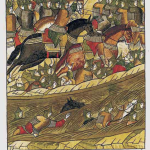10/1/2009
I was musing today on the ongoing boycott of the Jay Leno show and it got me thinking how few avenues there are in modern life for creative people. For those not in the know, television workers in LA are annoyed that the Leno show will effectively pre-empt five weekly, primetime shows and all the staff that would have been necessary to produce them. According to the disgruntled, running the Leno show at 10:00 PM is a cost-cutting measure that allows NBC to replace these five shows — and the artists and technicians employed in creating them — with one host and a skeleton crew.
Nothing against Leno who is an affable and innocuous guy, but if you assume that it takes 50 to 100 people to produce one original, prime-time hour of television, that’s a lot of creative people who potentially don’t have jobs right now.
Backtrack a few hundred years and you’ll find that there were a lot more outlets for creative types then because art was more routinely worked into public and private life. You didn’t even need to specialize in art to do art. Consider this: there were no televisions, radios, or cd/mp3 players, so people played music for themselves or hired musicians to play for them if they could afford such luxuries. People of all skill levels danced for their own entertainment as recently as the 1970s. They didn’t just watch stars do it badly on tv. Artists painted portraits and landscapes but they also painted frescos, murals, and ornate molding and trim. In those days, there was a need for sculptors, for textile specialists, for woodworkers, metalworkers, and all the rest.
It wasn’t just public art that did well in the past. Ordinary people also did arts and crafts in their daily lives. In most cultures, people wove, knit, and sewed to make baskets, bags, and clothing. More often than not, these self-made articles were decorative as well as serviceable. People made their own cabinets and furniture. People even built their own houses. Sure, much of life in the past was as mundane as it is today, but the arts thrived because there was so much more occasion to actually do art. We made everything ourselves and the artists among us did their best to make things beautiful.
But today, we don’t make anything ourselves. We buy it all readymade by machine from a big store full of other such dead objects made in factories far away. There’s no art — no love — in a plastic toy or a fleece blanket or a decorative basket of fake flowers.
That said, economics trumps art every time and consequently the artist/artisan is less viable as a thriving and needed member of the community. Art has been deemed expensive and hence expendable. Too bad for artists. We can’t afford them any more.
But that leaves us with another question: what is the artist to do in a society that doesn’t need art? Because of course there are still artistic types, creative minds, and crafty individuals among us and they all need something to do. If I were Scrooge, I could ask back: Are there no banks? are there no insurance companies? But not everyone is suited to the life of corporate drone.
So what shall we do with them? Surely paying them to do art is out of the question because, in general, our society does not reward creativity unless that creativity is focused on making money. For the most part, artistic effort, from tapestry to woodwork to big public sculptures, costs money. As for home crafters, think you can make it cheaper yourself? Think again….
So perhaps we are too populous and the world too depleted to afford the luxury of art. But that doesn’t mean we don’t still need it. People need creative outlets and people need art — real art, not just mass-produced artware and entertainment. Real art keeps us human. Without it, we risk becoming as dead as the products we buy.




